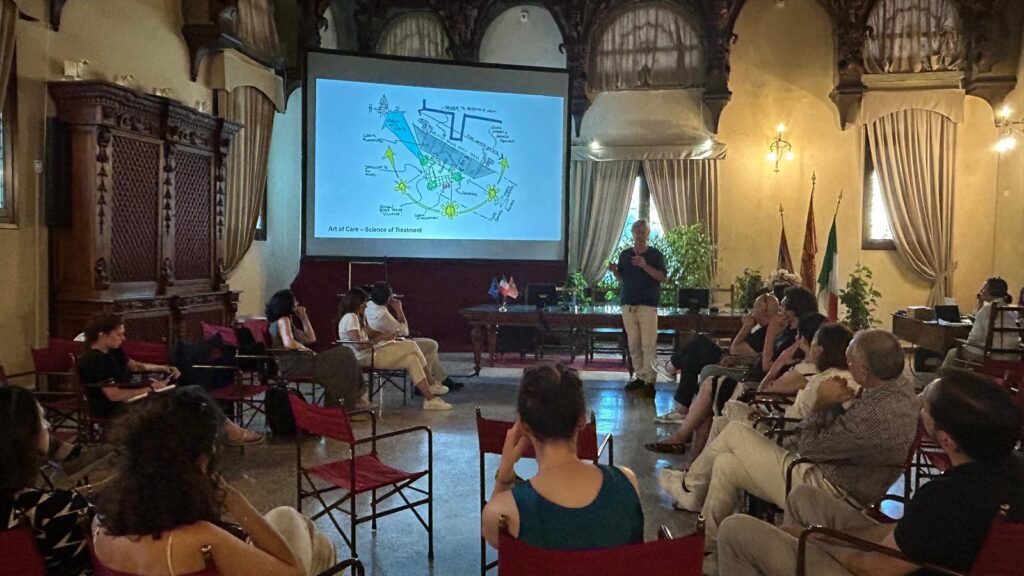The Health Benefits of our Surroundings
Comparing experiences of caring for cancer patients
Thursday 27 June, 19.00

The built environment in the healthcare sector, particularly in the oncology sector, has a strong impact on people, but if designed well and with sensitivity, it plays an essential role in supporting their well-being. Like buildings where no one would want to be (for example courts or prisons), the hospital, through spaces, materials and light, should in fact support the psychological condition of its users, first the patients who need to find hope in the future, and then the healthcare staff and caregivers in their work of caring for the sick. When cancer patients are asked what they need, they answer: time, access to drugs, access to diagnostics, psychological support and tranquillity. There are many factors that cause stress and discomfort in a hospital, from deafening noises to blinding lights to suffocating smells. A survey on patient satisfaction conducted at the IOV (Veneto Oncology Institute) showed that it is necessary to work on multiple fronts: space, lighting, silence. This is where the project for a “quiet room” inspired by international experiences starts. Of course, good ideas must take into account the economic constraints that prevent improvement that public facilities face compared to private health facilities. Working in synergy, architects and doctors agree on the need for a harmonious environment in which to face the treatment path of cancer patients. However, the guarantee of complete care and possibly the “proximity” of the figures who take care of the patient, remain central.
SPEAKERS
Filippo Cannata is the designer and founding partner of Cannata & Partners Illuminotecnici Comunicazione. Since 2003 he has been one of the main protagonists of the lighting designer scene and, in 2013 and 2022 he was included in the list of 100 Italian designers by Riccardo Dell’Anna Editore. He has collaborated with world-famous architectural firms such as those of Mario Cucinella, Mario Botta, Boris Podrecca, Richard Rogers, SOM and many others. A lecturer on the Master in Architettura e Salute, he believes that to find harmony with ourselves in times of crisis, we must create an environment capable of calming people who have lost hope and of allowing their dreams to resurface. After his experience as a patient, his priorities in lighting design have changed: he now aspires to help people manage the strong emotions experienced in an oncology environment.
Lorena del Río is co-founder of Rica* Studio New York – Madrid, an architecture firm and design research platform that works across scales, reflecting on the redefinition of flexibility and aiming to improve living conditions through architecture. Assistant Professor at Cooper Union, Del Río has also taught at Cornell University, California College of the Arts and MIT. Her academic research takes an interdisciplinary approach to design where architecture, art and material research converge allowing the investigation of the psychological effect of architecture and its ability to promote emotional well-being. After having lived the experience as a patient, observing the project of a paediatric oncology department, she further understood the value of architecture in improving the well-being.
Pietro Gallina works in the General Management Staff of the IOV, Veneto Oncology Institute-IRCSS. Graduated in Medicine and Surgery at the University of Padua in 1998, he subsequently obtained a specialisation in Geriatrics and a PhD in Clinical Physiopathology. After carrying out clinical and research activities, he developed his professional career in the field of healthcare management, with particular attention to chronicity. He was the healthcare manager of OIC Onlus from 2006 to 2010, Medical Director at the Azienda ULSS 16 (then ULSS 6 Euganea) until 2022, mainly dealing with outpatient specialist care and diagnostic-therapeutic care pathways (PDTA) of the oncology patient. He has numerous publications to his credit.
Valentina Guarneri is Director of the Oncology Unit 2 of the IOV, Veneto Oncology Institute-IRCCS. Since 2021, she has been Full Professor of Medical Oncology, University of Padua, Department of Surgical, Oncological and Gastroenterological Sciences, Healthcare Integration as Level II Medical Director at Medical Oncology 2 of the IOV-IRCCS. She has published numerous articles and has given over 300 national and over 90 international invited lectures. As a member of the scientific committee of the “Convegni Oncologici del Triveneto” she has contributed to the organisation of various educational activities and ECM courses. As a member of the scientific committee of Advanced International Breast, she contributes to the organisation of an annual conference that brings together the most eminent experts in breast cancer.
Ivan Harbour is an architect and senior partner at RSHP. Ivan’s work spans many types of buildings around the world, from airports to low-cost housing, where the designs embrace the common belief that successful buildings pay the utmost respect to those who use them. Two of Ivan’s projects – Terminal 4 at Madrid Barajas Airport (2006) and Maggie’s West London (2008) – have won the Stirling Prize, the UK’s most prestigious architecture award. Ivan is deeply involved in design from the urban scale down to the smallest detail and, together with Graham Stirk, promotes and develops the design ethos and quality for which the practice is renowned.
Caterina Frisone is the founder of the Master programme and creator, together with Massimo Zuin, of the cycle of panel discussions “Architecture and Healthcare, synergies and exchanges”. Firmly convinced that to improve the quality of hospital design it is necessary to adopt an interdisciplinary approach and raise the level of preparation of designers and technicians of healthcare services, Frisone is dedicated to stimulating the dialogue between architects/engineers and doctors/healthcare staff and to increasing the culture and knowledge of her students. The aim is to bring about a paradigm shift in the way architecture is considered in terms of its ability to improve the healthcare system.
